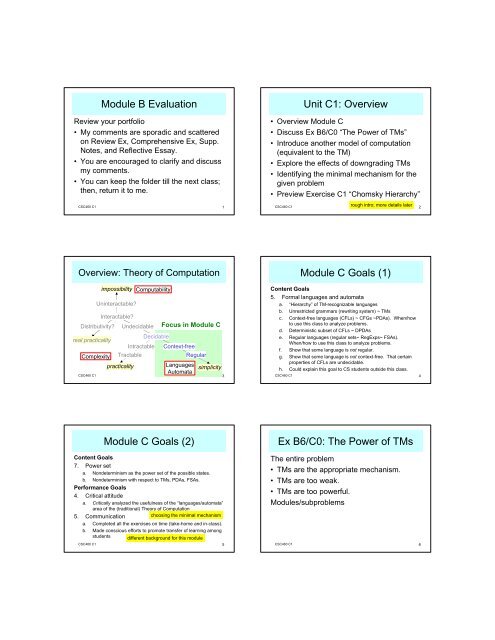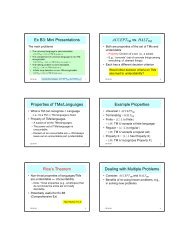Chomsky hierarchy - Nobo Komagata
Chomsky hierarchy - Nobo Komagata
Chomsky hierarchy - Nobo Komagata
Create successful ePaper yourself
Turn your PDF publications into a flip-book with our unique Google optimized e-Paper software.
Module B EvaluationReview your portfolio• My comments are sporadic and scatteredon Review Ex, Comprehensive Ex, Supp.Notes, and Reflective Essay.• You are encouraged to clarify and discussmy comments.• You can keep the folder till the next class;then, return it to me.CSC460 C1 1Unit C1: Overview• Overview Module C• Discuss Ex B6/C0 “The Power of TMs”• Introduce another model of computation(equivalent to the TM)• Explore the effects of downgrading TMs• Identifying the minimal mechanism for thegiven problem• Preview Exercise C1 “<strong>Chomsky</strong> Hierarchy”CSC460 C1 rough intro; more details later 2Overview: Theory of Computationimpossibility ComputabilityUninteractable?Interactable?Distributivity? Undecidable Focus in Module Creal practicalityDecidableComplexityIntractableTractableContext-freeRegularpracticalityLanguagesAutomatasimplicityCSC460 C1 3Module C Goals (1)Content Goals5. Formal languages and automataa. “Hierarchy” of TM-recognizable languagesb. Unrestricted grammars (rewriting system) ~ TMsc. Context-free languages (CFLs) ~ CFGs ~PDAs). When/howto use this class to analyze problems.d. Deterministic subset of CFLs ~ DPDAse. Regular languages (regular sets~ RegExps~ FSAs).When/how to use this class to analyze problems.f. Show that some language is not regular.g. Show that some language is not context-free. That certainproperties of CFLs are undecidable.h. Could explain this goal to CS students outside this class.CSC460 C1 4Module C Goals (2)Content Goals7. Power seta. Nondeterminism as the power set of the possible states.b. Nondeterminism with respect to TMs, PDAs, FSAs.Performance Goals4. Critical attitudea. Critically analyzed the usefulness of the “languages/automata”area of the (traditional) Theory of Computation5. Communication choosing the minimal mechanisma. Completed all the exercises on time (take-home and in-class).b. Made conscious efforts to promote transfer of learning amongstudents different background for this moduleCSC460 C1 5Ex B6/C0: The Power of TMsThe entire problem• TMs are the appropriate mechanism.• TMs are too weak.• TMs are too powerful.Modules/subproblemsCSC460 C1 6
Power-Economy Tradeoff• Complex mechanisms are more powerfulthan simple ones (can represent morevariety of problems/languages).• Simple mechanisms are less expensivethan complex ones (can operate simplyand faster in general).• An appropriate level would be the leastpowerful one for the requirement.CSC460 C1 7Downgrading TMs• Imposing a specific tape organization– As a stack– As a queue• Limiting the tape size– Set some finite fixed bound– Limit the growth (e.g., linearly with the input)• Limiting the head mechanism– Read-only– One-way scanning onlyCSC460 C1 alternative models 8TM-Equivalent ModelsReviewIdentifying Alternative ModelsTM variationsURMComputers ?TM λ-calculusRecursive Functions• Problem ~ set– Most commonly as a language (set of strings)– Recognized by a TM• Whatever mechanism that can recognize(or generate) a string can be examined forthe equivalence with a TM (or somedowngraded forms).CSC460 C1 Other models? 9CSC460 C1 10Grammar• Grammar [unrestricted grammar, semi-Thue system]– Rewrite rules of the form: α → βwhere α, β are strings of symbols and |α| > 0• S → NP 1 V NP 2• NP 1 V NP 2 → NP 2 is Ved by NP 1• NP 1 → liisa | tiina• NP 2 → mikko | seppo• V → kisses | kicks• Ved → kissed | kickedCSC460 C1 11TM vs. grammar?Using a Grammar• Generating a string• Accepting a string (parsing)• S → NP 1 V NP 2• NP 1 V NP 2 → NP 2 is Ved by NP 1• NP 1 → liisa | tiina• NP 2 → mikko | seppo• V → kisses | kicks• Ved → kissed | kicked• Terminal symbols [lower case]: Cannot be rewritten• Nonterminal symbols [UPPER CASE]: Must be rewrittenCSC460 C1 12
TM vs. Grammar• Equivalent!• I.e., both can recognize/generate exactlythe same class of languages– TM-recognizable– Recursively enumerable (RE) [standard term inthis context]• Proof idea– A grammar simulated by a TM– A TM simulated by a grammarCSC460 C1 13TM or Grammar?• Modeling computation• Modeling function• Classifying sets (including computationalproblems)• Declarative specification• Specification of programming languages• Description of human languages• Analysis of different classesCSC460 C1 14Grammar Variations• Conditions on the length of LHS (left-handside) and/or RHS• Conditions on the type of string on theRHS• S → NP 1 V NP 2• NP 1 V NP 2 → NP 2 is Ved by NP 1• NP 1 → liisa | tiina• NP 2 → mikko | seppo• V → kisses | kicks• Ved → kissed | kickedCSC460 C1 15Grammar Hierarchy• Type 0: Unrestricted Grammar• Type 1: Context-Sensitive Grammar(CSG)• |LHS| ≤ |RHS| [i.e., no shrinking]• Type 2: Context-Free Grammar (CFG)• |LHS| = 1 [i.e., ignore the context of rewriting]• Type 3: Regular Grammar ~ Regular Expression– RHS has at most one nonterminal at theleft/right edge.examples?CSC460 C1 16Automata Hierarchy• Type 0: TM• Type 1: Linear Bounded Automaton (LBA)– Tape space limited to the input size• Type 2: Pushdown Automaton (PDA)– Tape as a stack (with a separate input tape)• Type 3: Finite-State Automaton (FSA)– Head movement only to the rightLanguage Hierarchy• Type n languages are accepted/generatedby Type n grammars and recognized byType n automata.• Type 0: RE (TM-recognizable)• Type 1: Context-Sensitive Languages(CSLs)• Type 2: Context-Free Languages (CFLs)• Type 3: Regular LanguagesCSC460 C1 schematics17CSC460 C1 18
<strong>Chomsky</strong> HierarchyType 0 TM-recognizable (RE) Grammar/TMType 1Type 2Type 3Context-SensitiveContext-FreeRegularCSG/LBACFG/PDARegExp/FSAContributions of <strong>Chomsky</strong>CSC460 C1 19Group Exercise 1Identify the minimal type for the following• Pattern matching?• Programming language specification?• Representing human language?Discuss the following• Effects of nondeterminism?• Is the <strong>hierarchy</strong> exhaustive?– Where is the set of decidable languages?– Class like Type 1.5?See Ex C1CSC460 C1 20Recursive SetsExtended <strong>Chomsky</strong> Hierarchy• Decidable = Recursive• Theorem: CSLs ⊂ Recursive Sets (i.e.,proper inclusion)• Proof idea– CSLs ⊆ Recursive Sets– There is a recursive set that is not a CSL.TM-recognizable (RE)Decidable (Recursive)Context-SensitiveContext-FreeRegularGrammar/TM?/DeciderCSG/LBACFG/PDARegExp/FSACSC460 C1 21CSC460 C1 22Power-Economy Tradeoff, Revisited• Higher-level grammars/automata are morepowerful than lower-level ones (canrepresent more variety of languages).• Lower-level grammars/automata are lessexpensive than higher-level ones (canoperate simply and faster in general).• An appropriate level would be the leastpowerful one for the requirement.Unit Summary• Grammars• Connection between grammars, automata,and languages (problems)• <strong>Chomsky</strong> <strong>hierarchy</strong>• Identifying the minimal mechanism for thegiven problemCSC460 C1 23CSC460 C1 24
Summary Question• What would be your guiding principleto identify the simplestmechanism/approach (not necessarilyin CS)? Explain.• Questions/Comments/SuggestionsCSC460 C1 25



